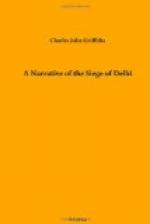The genius of Sir John Lawrence, the Chief Commissioner of the Punjab, warded off the danger. That eminent man, the saviour of India, issued a proclamation calling on the Sikhs to aid us in our trouble. They came at once in hundreds—nay, thousands—to enlist on our side. Veterans of Runjeet Singh’s Khalsa army, the men who had withstood us on equal terms in many sanguinary battles, animated by intense hatred of the Poorbeah sepoy, enrolled themselves in the ranks of the British army, and fought faithfully for us to the end of the war. Their help was our safety; without these soldiers, and the assistance rendered by their chieftains, Delhi could never have been taken; while, on the other hand, had they risen and cast in their lot with the mutinous sepoys, no power on earth could have saved us from total annihilation.
The Sikhs are the beau-ideal of soldiers. Tall and erect in bearing, wiry and well-knit, and of great muscular development, their whole appearance stamps them as men who look upon themselves as “lords of the soil,” whom it would be difficult to conquer. And without doubt the campaigns of 1845-46 and 1848-49 were the hardest in which we had been engaged in India.
For 100 years they had dominated the land of the Five Rivers. Ever eager for war, their turbulent spirits gave them no rest. It had been a belief that they would in the future acquire the sovereignty of Hindostan, and I know for certain that among the soldiers for many years there had been a tradition that one day they would sack the imperial city of Delhi.
The latter expectation was in a manner fulfilled; but not as an independent nation or under their own leaders did they capture and plunder the Mohammedan capital: they accomplished that feat as loyal subjects of the British Crown.
Every now and then news reached us of the spread of the Mutiny, till from Calcutta to Peshawar there were few stations where the native troops had not joined in the rebellion. Cavalry, infantry, and artillery, all had risen in revolt. The wave of mutiny was surging to and fro throughout the land, and as yet little had been done to stem the tide. True, a small force was being assembled at Umballah, which, under the Commander-in-Chief, was about to march to Delhi, but of the doings of that army we could learn no satisfactory tidings.
The closing days of the month of May passed wearily by, and time hung heavily on our hands. We felt the inevitable reaction from the first few days of excitement, and also missed the comforts and ease to which we had been accustomed in former hot seasons. The barracks were close and stuffy, and the officers, in place of the luxury of their bungalows and their pleasant mess, had to endure privations of every kind.




